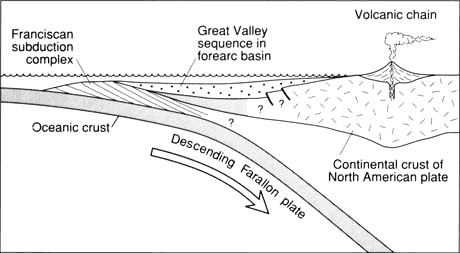
Cross-section from US Geological Survey Professional Paper 1515
Today the Cascade Range volcanoes are produced by this mechanism. California members of the Cascades include Mount Lassen, which last erupted in 1917, and Mount Shasta, which may have erupted in the 1700s. South of that, this system was interrupted when the San Andreas fault system formed and began extending northward (now the boundary between the two tectonic regimes is a triple junction at Cape Mendocino). An example of Cascade volcanic deposits crops out south of Ocean Beach near San Francisco, a prominent ash bed in the seacliffs of the Merced Formation. It's known as the Rockland ash and came from an ancestor of Lassen volcano, called Mount Tehama, about 600,000 years ago.
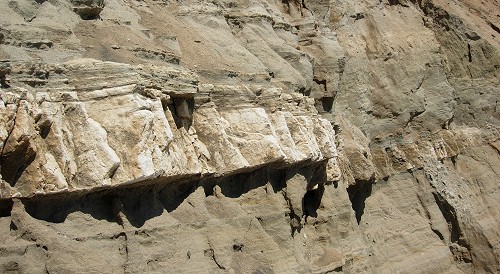
The second major kind of California volcanism is beyond the Sierra, in the Mammoth Lakes area and points south. The last "supervolcano" eruption from that area was about 700,000 years ago, and ash from it (the Bishop Tuff) fell here although I don't know where to point you to it. That volcanism is related to stretching of the crust in the Basin and Range province, which basically includes all of Nevada and surrounding counties.
The third type of volcanism is related to Yellowstone, of all places. The geysers and lava flows of Yellowstone are the current location of an eruptive center that began about 16 million years ago in Oregon and slowly burned its way eastward across Idaho, leaving enormous plains of solid lava behind. Northeastern California has a lot of it. One of the first eruptions in that series came from California, sending a glowing flood of basalt lava our way. It flowed more than 200 kilometers as far as Vacaville, where it's mapped as the Putnam Peak Basalt.
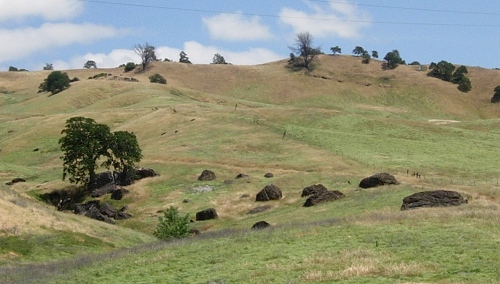
Boulders of basalt akin to that in Yellowstone and Idaho lie west of Winters.
You can inspect this rock at leisure on Route 128 west of Winters, about 2 miles west of Pleasants Valley Road. It's the location given at the top of this post.
OK, on to our own local volcanism. As the San Andreas fault system cut northward through our region, it cut off the preexisting subducting plate like a letter opener slicing across an envelope. The plate continued to descend, leaving behind it a traveling "slab window" that briefly allowed the hot underlying rocks of the Earth's mantle to send up magma. In the Bay Area, slab-window volcanic rocks came in three pulses. The first pulse dates from 11 to 8.5 million years ago. Its lavas have been dismembered by motion along the San Andreas and related faults, and now it occurs east of Hollister (the Quien Sabe Volcanics), in the East Bay Hills (well exposed in Sibley Volcanic Regional Preserve), at Burdell Mountain in Marin County, and the Tolay Volcanics between Petaluma and Santa Rosa.
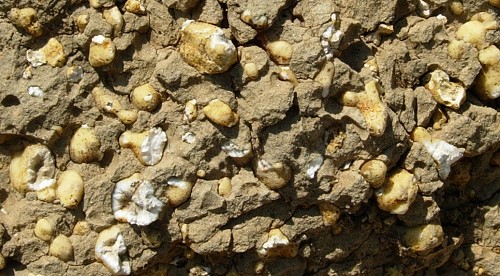
Mineral-filled bubbles in lava beds at Sibley Volcanic Regional Preserve
The next pulse of slab-window volcanism produced the large Sonoma Volcanics between 8 and 2.5 million years ago. A good place to see these is at the Petrified Forest park west of Calistoga, where whole redwood trunks have been fossilized in the silica-rich ash.
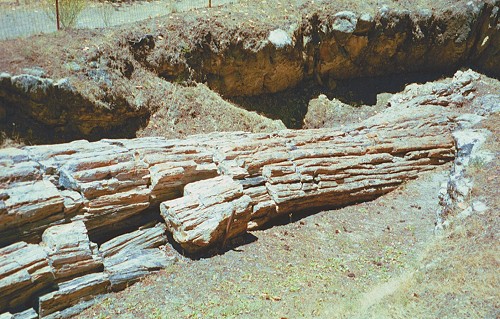
Since then, slab-window volcanism has migrated north to the Clear Lake/Geysers region. Mount Konocti, overlooking the lake, is a recent volcanic construction. The famous hot springs get their heat from this volcanism. And the huge geothermal power complex at The Geysers, based on natural steam heated by underlying magma, supplies electricity to the Bay Area, helping you read this story.
38.5175 -122.0561
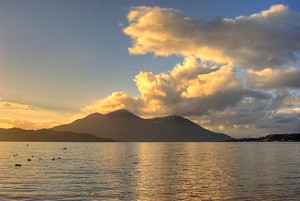 Former volcano Mount Konocti overlooks Clear Lake. Photo courtesy Stephen Nakatami of Flickr under Creative Commons license; all other photos by Andrew Alden.
Former volcano Mount Konocti overlooks Clear Lake. Photo courtesy Stephen Nakatami of Flickr under Creative Commons license; all other photos by Andrew Alden.




